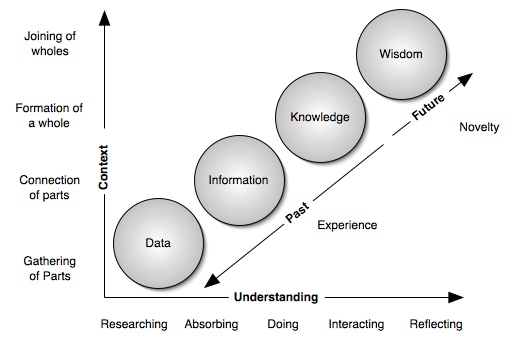Note: This site is moving to KnowledgeJump.com. Please reset your bookmark.
Information
Inform originally meant to give shape to; while information is meant to shape a person.
Information comes from the form that data takes as it is arranged and presented in different ways. This “massaging” of the data adds context to it and allows us to understand something about the data that is presented to us. Researchers often describe information as a message that is communicated. As with any message, it has a sender and a receiver. The purpose is to change the receivers' way of perceiving something so as to cause an impact on their judgment and behavior.
Think of information as data that makes a difference. — Davenport & Prusak (1998)
Organization and Structure
Information may be infinite, however... the organization of information is finite as it can only be organized five ways—LATCH (Wurman, 2001):
- Location
- Alphabet
- Time
- Category
- Hierarchy
In addition, information is normally structured around five degrees of immediacy to our lives (Wurman, 2001):
- Internal: The messages that run through our systems and allows our body to function
- Conversational: The formal and informal exchanges that we have with the people around us.
- Reference: Runs the system of our world -- science and technology -- such as a book or dictionary.
- News: Current events that is transmitted via the media.
- Cultural: History, philosophy, and the arts. This is the least quantifiable form.
Shareability
Shareability refers to the extent to which information is shareable. Information has high shareability if it is easy to share between different individuals without loss of fidelity. Shareability theory proposes that internal (e.g. perceptual, emotional, imagistic) information often is qualitatively different from external (e.g. spoken, written) information, and that such internal information is often not particularly shareable. - What is Shareability? by Jennifer J. Freyd
Patterns
A pattern shows relations among groups of information so that there is both a consistency and completeness of relations. This creates its own context, which serves as an archetype — foundational structures of thought that surface over and over again through human history and across cultures so that both repeatability and predictability are implied.
Patterns become knowledge when a person is able to realize and understand the patterns and their implications, that is, they become more self-contextualizing.
Next Step
Click on the various parts of the chart to learn more about that topic

Reference
Davenport T., Prusak, L. (1998). Working Knowledge. Harvard Business School Press: Boston, MA.
Freyd, J.J. (2003). What is Shareability? Retrieved May 10, 2004 from http://dynamic.uoregon.edu/~jjf/defineshareability.html
Wurman, S. (2001). Information Anxiety 2 Indianapolis: Que.

